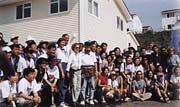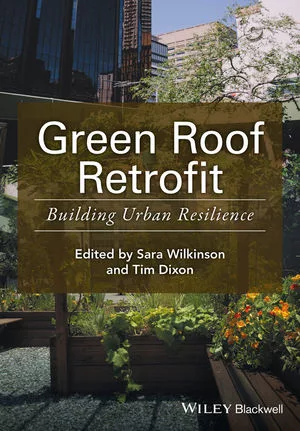West Meets East


The Carters worked on the construction of House Fourteen at the Asan site, one of six construction sites throughout South Korea. The JCWP was held in conjunction with the “World Leaders Build,” which had world leaders from 26 nations building with HFHI in 43 countries. South Korea’s president, Kim Dae-jung came to the Asan site to meet with Carter. Back home, current U.S. President George W. Bush, and his wife, Laura, worked on a new home for the Evans family in Waco, Texas.
The site at Asan was the primary building site and the weeklong construction project called for the completion of 20 buildings, each with living space for four families. The site work was complete and the foundations through the roof framing and decking were in place when volunteers arrived on the site on Monday. The job was to completely finish the units inside and out by Friday. A total of 500 volunteers from the United States were spread across all six building sites. The author worked on House Two at the Asan site. Another 9,000 or so other volunteers, some from Japan, Australia and Europe, but mostly from Korea, rounded out the building force. Volunteers came from all quarters, some working as part of their company’s sponsorship efforts, some with church groups, and many as individuals contributing their own time. Some worked a week; others worked a day or two.
The construction was in line with regional standards, but a number of the components were uniquely American. The roofing and siding (of course, the parts we participated in) were standard fare for the United States. Dow Chemical Co. supplied its blue Styrofoam exterior wall sheathing for all the homes in Asan. Dow is a major supporter of HFHI. The shingles were three-tab fiberglass and the siding was double-four clapboard vinyl in various colors and brands. House Two received GAF Sentinels while other homes on the build received shingles by CertainTeed. The roofing and insulation industries were well represented on this build, as they have been for many years. Roofing and insulation industry manufacturing companies known as major supporters of HFHI include Dow, CertainTeed, GAF, Johns-Manville, Monier-Lifetile, Georgia-Pacific, and others.
Logistics for construction of this type are unique and challenging. HFHI has developed a number of methods and protocols that are impressive. While volunteer labor is cheap, there are a number of special considerations that must be made when using talent that runs the gamut from non-skilled to somewhat skilled to skilled. They must be fed and housed, too. Volunteers from the United States had to pay a nominal sum for room and board, and provide their own transportation. There are a number of HFHI “pros” on the sites, but most of the leadership at the house construction level is voluntary.
The job-site hierarchy goes down as follows: site leader, block leader, house leader, inside leader and outside leader, and finally crew leaders. When it comes to crew leaders, organizing on the first day usually settles who goes where, not unlike a pick-up game of flag football. It happens that one of my Atlanta buddies, Jeff Moore, was the outside house leader on House Two. He didn’t even say hello before saying, “You’re doing the roof!”
The great thing about nailing strip shingles is the sheer simplicity. Add to that, the fact that typical construction of HFHI homes is very simple. If they weren’t, rookies such as the author would never be able to run crews of other rookies to install the roofing. The homes built for HFHI Korea in Asan were supremely simple. Two sides, no penetrations from plumbing, HVAC, or electric. It would be nice to bring this methodology over here. All exhaust was done through the sidewalls. The only accessory was the Cobra ridge vent. This allowed us the luxury of taking plenty of time to lay the roof out and get it on within the scheduled time. We declared victory on Tuesday morning, having taken most of Monday afternoon off due to heat too brutal for a bunch of “inside guys” to handle.
The roof was not without a few challenges. To begin with, the shingles were metric. No real problem, except a few of us had English tape measures, while everyone else had metric. In short order, metric won and we were set to go. There was a question on the nailing pattern, which was settled for me by our house leader, Mr. Choi. Choi is Korean, but speaks excellent English. Asan is not in an area directly affected by typhoons, but there was a requirement that called for us to six-nail all shingles on the perimeters. In some areas of the Korean peninsula the codes call for eight-nailing all shingles followed by cementing every tab.
Language was a bit of a barrier to good communication, but it caused those of us responsible for getting a message across to partner with the Koreans who demonstrated superior command of the English language. Cargill/Purina – Korea & China was a sponsor of House Two, and always had an ample supply of executives on hand who made excellent translators and crew leaders. Cargill executive Jay K. Ko was the chief translator on the roofing crew. We were also joined by a number of students. Student Timothy Ray Yang provided translation service for the siding crew. He is Korean, speaks very good English, is a student at a high school for international language studies, and is currently studying Japanese. Amazing.
The build was completed on time, and there were only minor inconveniences, such as a sudden downpour on Tuesday afternoon that arose so fast that many workers were drenched just trying to make it off the scaffolding. A couple of the bus rides throughout the countryside were interesting as well. You know you have a problem when the bus driver stops for the third time to ask a person walking down the road for directions. As for the local culture and cuisine, all the volunteers were treated to a good taste. Only able to speak for one, the food was hot, spicy, plentiful, and good. Rice and kimchi were present at every meal. You know what rice is. Suffice it to say simply that kimchi is fermented cabbage typically spiced with a peppery seasoning. The Korean people were all very accommodating and seemed to enjoy hosting us as much as we enjoyed being there.
Speaking of people, the build took on a life of its own based on the variety of people who came to work, from former presidents to a considerable media contingent, most of whom were there strictly to take photos or interview politicians (not perform construction work). It was good to meet the executives from Cargill/Purina. In fact, the CEO of the firm was there with the other volunteers, shoulder to shoulder, planting trees and tending to a number of finishing details. As always, the homeowners worked along with the other volunteers. “Sweat equity,” as it is known, is one of the requirements for home ownership with HFHI. According to HFHI founder, Millard Fuller, “The houses being built at this year’s JCWP and the World Leaders Build will house families who are truly in need…. I am so thrilled to know that our work in Korea will bring us a step closer to meeting our goal to build another 100,000 homes by 2005.”
Few construction jobs you will encounter come with so many benefits for the workers: Like being able to sing “Amazing Grace” in English in the middle of a chorus of ladies singing the same in Korean; or having a few minutes on Friday afternoon to spend in the nearly completed homes with their new occupants; or the beautiful face of the little boy who called me, “Jimmy Carter!” One could not help but draw energy and inspiration from the volunteers, both American and the others, who worked so very hard despite the heat and the challenges of doing a job while learning it.
Then there were some very tangible benefits, such as the local hot springs and the inexpensive massage service that came in handy after a day of manual labor. Just the adventure of traveling halfway around the world to do this work was pretty special. Working closely with young people is always an invigorating and enlightening experience. The language differences made for lots of hand gesturing and “show me” kind of teaching and learning. Those of us who came to show others some things about our construction methods learned so much more from our hosts, particularly what a graceful and gentle people our Korean friends really are.
The week was capped by a closing ceremony at the Asan site that featured speeches by Fuller and Carter along with local entertainers and a fireworks display. It was announced that the goal of 120 homes was exceeded with a total of 136 units being completed. Next year the JCWP will be held in Durban, South Africa.
This particular task is complete, but there is a long way to go for HFHI. Habitat celebrated 25 years of constructing simple decent homes with people in need (note with, not for). In these 25 years, HFHI homeowners and affiliates have constructed over 100,000 dwelling places in over 70 countries across the globe. The goal at hand is to build another 100,000 by 2005. Given the dedication and passion of the volunteers and homeowners we witnessed in South Korea, expect this goal to be met, and possibly exceeded! To be a part of it, contact Habitat for Humanity International, 121 Habitat Street, Americus, GA 31709. For more information on HFHI, look them up on the Web at www.habitat.org.
Sidebar
Habitat for Humanity International
- A non-profit, ecumenical Christian housing ministry
- Seeks to eliminate poverty housing and homelessness from the world, and to make decent shelter a matter of conscience and action
- HFHI has built more than 100,000 houses around the world providing more than a half-million people with safe, decent, affordable shelter.
- Habitat was founded in 1976 by Millard Fuller along with his wife, Linda
- Through volunteer labor and donations of money and materials, Habitat builds and rehabilitates simple, decent houses with the help of homeowner (partner) families
- Habitat houses are sold to partner families at no profit, financed with affordable, no-interest loans
- The homeowners monthly mortgage payments are used to build still more Habitat homes
- Throughout the world, the cost of houses varies from as little as $800 in some developing countries, to an average of $46,600 in the United States
- HFHI’s work is accomplished at the community level by affiliates – independent, locally run, nonprofit organizations
- There are more than 1,900 active affiliates in 79 countries including all 50 states of the United States, the District of Colombia, Guam and Puerto Rico
- Partner families are selected based on level of need, willingness to participate in the program and ability to repay the no-interest loan
- Neither race nor religion is a factor in choosing partner families
- Habitat is not a governmental agency and does not accept government funds for construction of houses, but does work with government agencies toward fulfilling its mission of eliminating poverty housing
- HFHI is managed by an ecumenical, international board of directors
Looking for a reprint of this article?
From high-res PDFs to custom plaques, order your copy today!





